Contents
As a business leader, you always look for ways to scale efficiently without drastically increasing costs. But when project deadlines are tight and your team is already at full capacity, finding skilled talent becomes a major challenge. Growing companies often face this roadblock: tech talent shortages. The longer it takes to hire the right people, the more your roadmap suffers.
Hiring locally is an option, but it’s expensive and time-consuming. Local hiring may take 3-6 months vs. 2-3 weeks for nearshore onboarding. Offshoring might save operational costs, but late-night meetings, cultural differences, and language barriers can disrupt collaboration.
So, what’s the smarter alternative?
The nearshore staff augmentation model offers a practical and balanced solution. Hiring skilled professionals from neighboring countries like Latin America, such as Mexico, Colombia, and Argentina, gives you access to top talent without the typical offshoring challenges—the same time zone, fewer barriers, and a streamlined workflow.
By leveraging nearshore software development services, businesses can build agile, collaborative teams that function almost like in-house units. This approach enhances productivity while maintaining cultural and operational alignment.
But is nearshore staff augmentation the right fit for your business? Let’s break it down and explore everything you need to know. Starting with the adoption of this nearshore model-
Growing Adoption of the Nearshore Staff Augmentation Model
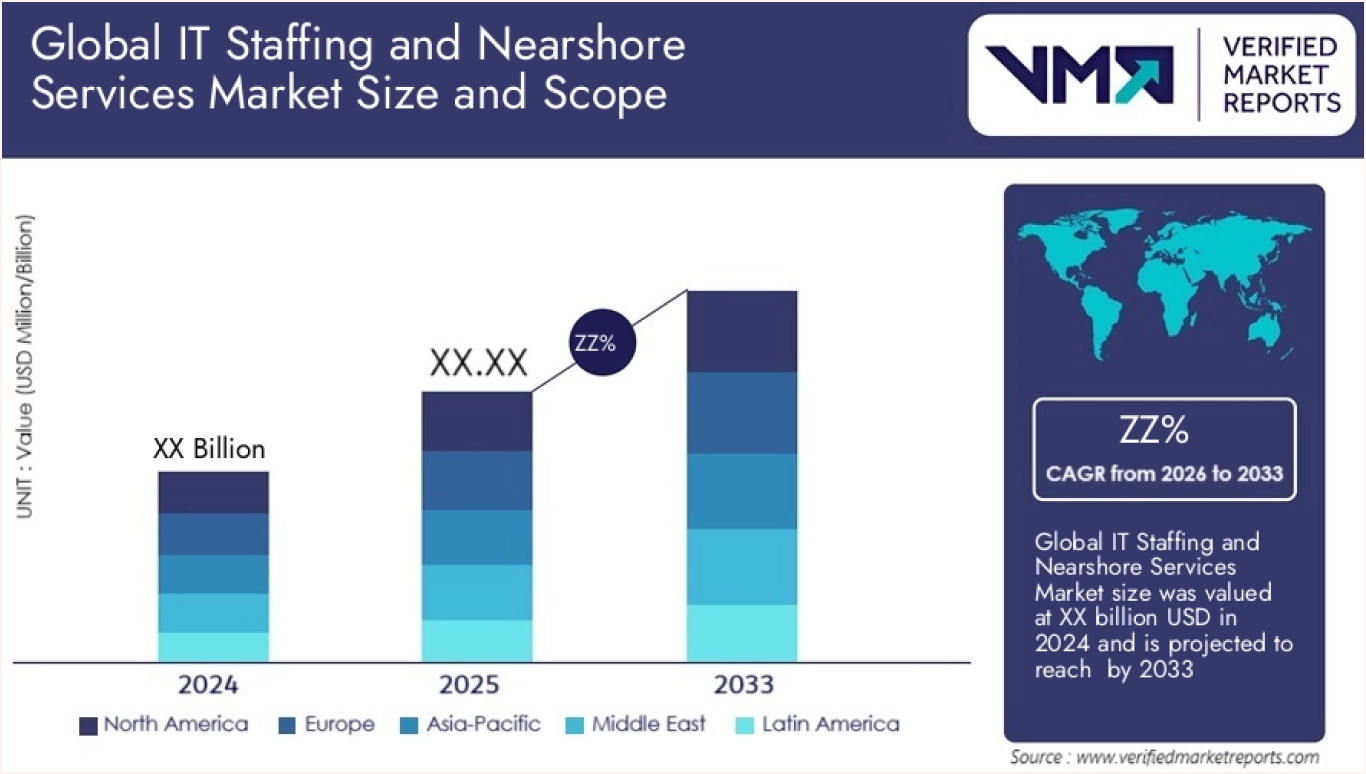
Source: Verified Market Reports
The nearshore staff augmentation model is rapidly gaining popularity across industries, driven by its ability to address modern business challenges such as talent shortages, cost efficiency, and operational agility. Below are key trends and statistics listed by Verified Market Reports highlighting why businesses are increasingly adopting this model:
- The IT staffing and nearshore services market was valued at approximately $38 billion in 2022 and is projected to grow to around $55 billion by 2028.
- The tech sector is projected to grow by about 13% from 2020 to 2030, significantly boosting the demand for Agile staffing models, including nearshore services.
- Latin America is emerging as a prime nearshore destination due to its competitive labor costs, abundant skilled professionals, favorable time zone alignment with the USA, and cultural compatibility.
- Companies leveraging nearshore staff augmentation can achieve cost savings estimated at 25–40% compared to onshore hiring, without sacrificing quality.
The growing adoption of nearshore staff augmentation is not just a passing trend—it’s a strategic shift addressing critical business needs. As industries navigate talent shortages, increasing digital demands, and the necessity for Agile operational models, nearshore services are proving an effective solution.
So, what exactly is nearshore resource/staff augmentation?
Nearshore Staff Augmentation Explained

Nearshore staff augmentation is a strategic hiring model where companies extend their in-house teams by partnering with skilled professionals from nearby countries. This approach allows businesses to access a pool of highly qualified talent in similar time zones, ensuring smoother collaboration and real-time communication.
Unlike traditional outsourcing, nearshore IT staff augmentation provides greater control over projects, faster onboarding, and cost-effective scalability while maintaining cultural and operational alignment. For instance, instead of a vendor handling everything, your PM collaborates directly with nearshore engineers.
It is widely used for IT, software development, and tech-related roles, helping businesses bridge skill gaps without the complexities of hiring full-time employees. However, nearshore staff augmentation isn’t limited to software developers. You can tap into a broad spectrum of specialized roles to meet virtually any project need. It includes Quality Assurance & Testing, UX/UI & Graphic Designers, DevOps & Cloud Specialists, marketing & sales roles, and so on.
How does Nearshore staff augmentation differ from Offshore and Onshore models?
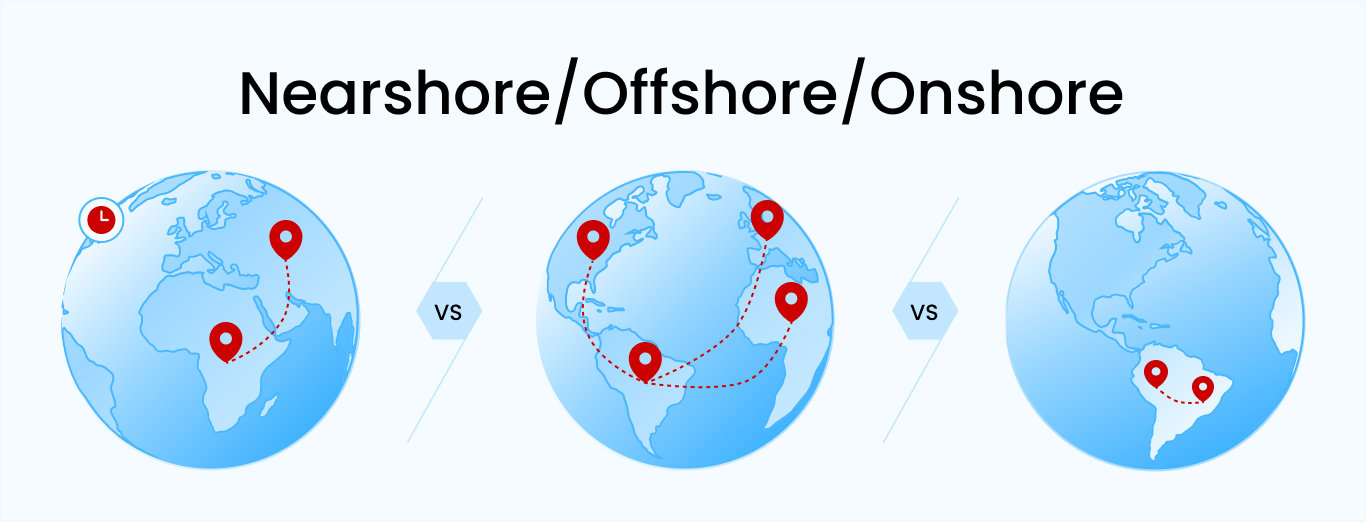
Scaling your team starts with picking the right staffing model. You can choose onshore, offshore, or nearshore augmentation.
- Onshore hires work in your country. Communication is seamless but costs are high.
- Offshore teams are very cost‑effective. However, time‑zone gaps and language differences can slow you down.
- Nearshore sits in between. You tap talent from nearby countries. Overlapping hours make meetings easy. Similar cultures and legal systems reduce risk.
Each model has trade‑offs. Onshore gives you top local talent and instant collaboration at a premium price. Offshore lets you stretch your budget, but you may face delays and compliance hurdles. Nearshore blends both. You get quality skills at better rates than onshore. You enjoy real‑time teamwork and simpler contracts. For many businesses, nearshore strikes the best balance of cost, speed, and reliability.
Optimize Your IT Workforce with Nearshore Staffing
Access skilled nearshore teams that deliver rapid integration and operational excellence for your IT projects.

What are the Top 5 Benefits of Nearshore Staff Augmentation?
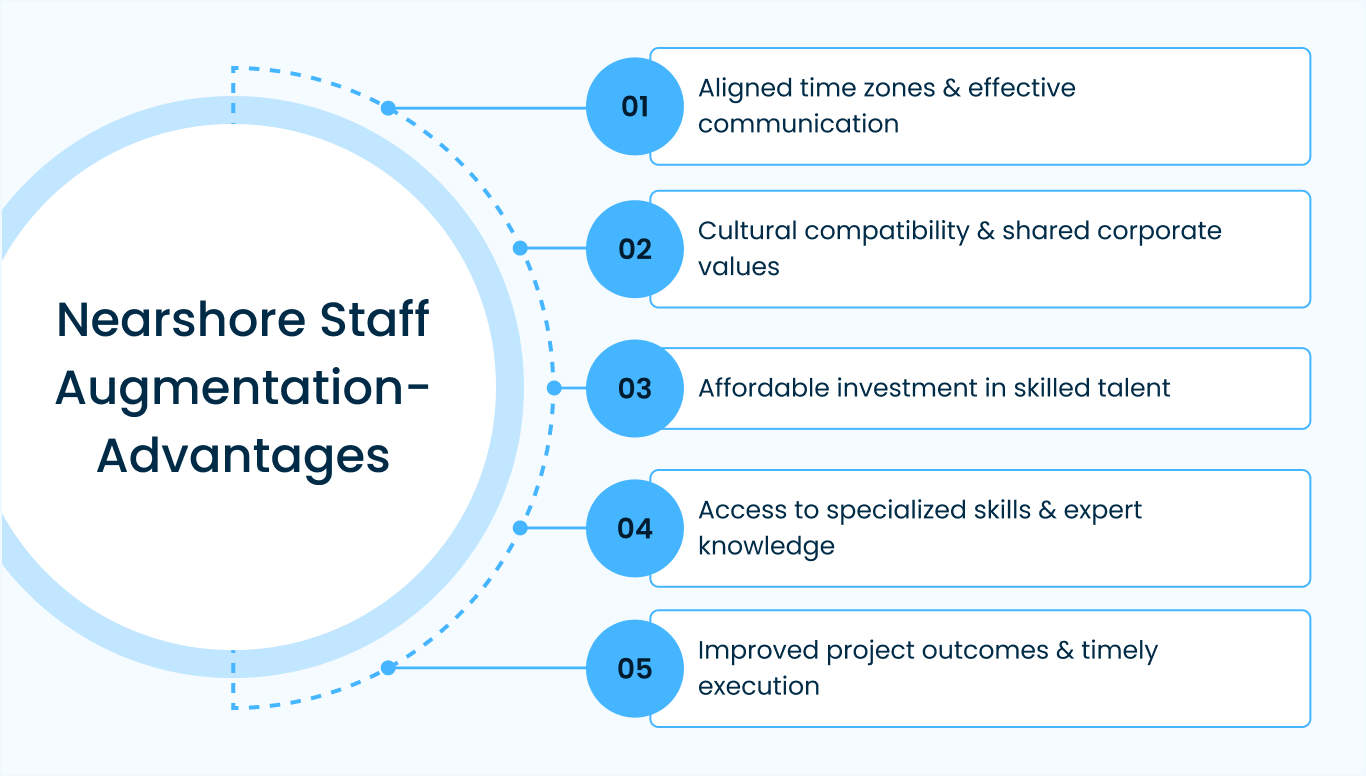
Nearshore staff augmentation allows businesses to expand their teams efficiently while ensuring affordability and operational flexibility. By collaborating with nearshore software development companies from neighboring countries, companies can access skilled experts who align with their time zones, cultural expectations, and technical requirements.
Aligned time zones & effective communication
Nearshore teams are often located in Latin American countries such as Mexico, Colombia, Argentina, Brazil, Chile, and Costa Rica. They share similar time zones with your in-house teams. This alignment enables real-time communication and prompt issue resolution. The proximity in working hours minimizes scheduling conflicts and promotes smooth collaboration throughout the day.
Cultural compatibility & shared corporate values
Nearshore staff augmentation services focus on cultural alignment. Teams from nearby regions understand your company culture and business values. They work well with your in-house employees and reduce the impact of language barriers. This cultural compatibility fosters a productive and friendly work environment.
Affordable investment in skilled talent
Skilled professionals are available at lower hiring costs compared to onshore outsourcing. The nearshore staff augmentation model offers a cost-effective solution while delivering quality talent. For example, according to the data found from PayScale & Indeed, the hourly rate of a software developer in LATAM is around USD 27 to 35, whereas in the USA, the cost is USD 54 and can go as high as 120.
This approach reduces overall hiring expenses and streamlines budget management. It allows your business to access experienced software developers without overspending.
Access to specialized skills & expert knowledge
Dedicated teams bring the specific expertise needed for your software development projects. Many Latin American countries provide highly skilled software developers with specialized technical skills. This model gives you access to a broad talent pool that meets your IT department’s requirements. It supports your development team with targeted expertise and technical proficiency.
Improved project outcomes & timely execution
Teams located in Latin America work in sync with your business objectives. They deliver projects with a focus on quality and timely execution. Their proximity allows for real-time collaboration that leads to better project outcomes. Integrating nearshore services results in faster project delivery and measurable business improvements.
When Should You Choose Nearshore Staff Augmentation?

Nearshore staff augmentation can be a smart choice for businesses looking to expand their external teams efficiently while balancing cost, communication, and collaboration. Here’s when you should consider it:
- When You Need Similar Time Zones: Nearshore staff augmentation services shine when you want real-time collaboration. If your team is in North America, working with a development team in Latin America (like Mexico or Costa Rica) means overlapping hours, making meetings smoother than with offshore teams in distant time zones.
- When Cost Matters, But Quality Can’t Slip: Nearshore services are cheaper than market hiring in the U.S. or Western Europe, yet still offer skilled professionals for software development. They provide cost-effectiveness and expertise, like software development staff augmentation, compared to offshore outsourcing options, where quality varies.
- When Cultural Alignment Helps: Nearshore teams often share norms with U.S. or Canadian firms, leveraging a partner’s regional expertise for fewer misunderstandings. Unlike some offshore talent, this aligns goals faster, especially for client-facing nearshore staff augmentation needs.
- When You Need Flexibility Fast: For workload spikes, the nearshore staff augmentation model scales quickly without long-term ties. An experienced team can join in weeks, helping you efficiently accomplish goals and scale back post-crunch, optimizing human resources.
- When Language Matters: If English or Spanish is key, nearshore outsourcing offers stronger skills, reducing language barriers. This suits tech support or sales, unlike some software development outsourcing alternatives.
- When Travel Is Occasionally Needed: Proximity aids the staff augmentation strategy. A short flight from the U.S. to Colombia or Jamaica for training beats a haul to Eastern Europe, fostering ties without high costs.
In short, opt for a staff augmentation company using this model when balancing affordability, quality, and collaboration. It gives businesses a competitive edge in markets and helps them remain productive by effectively utilizing talent.
How to Approach Nearshore Staff Augmentation Successfully
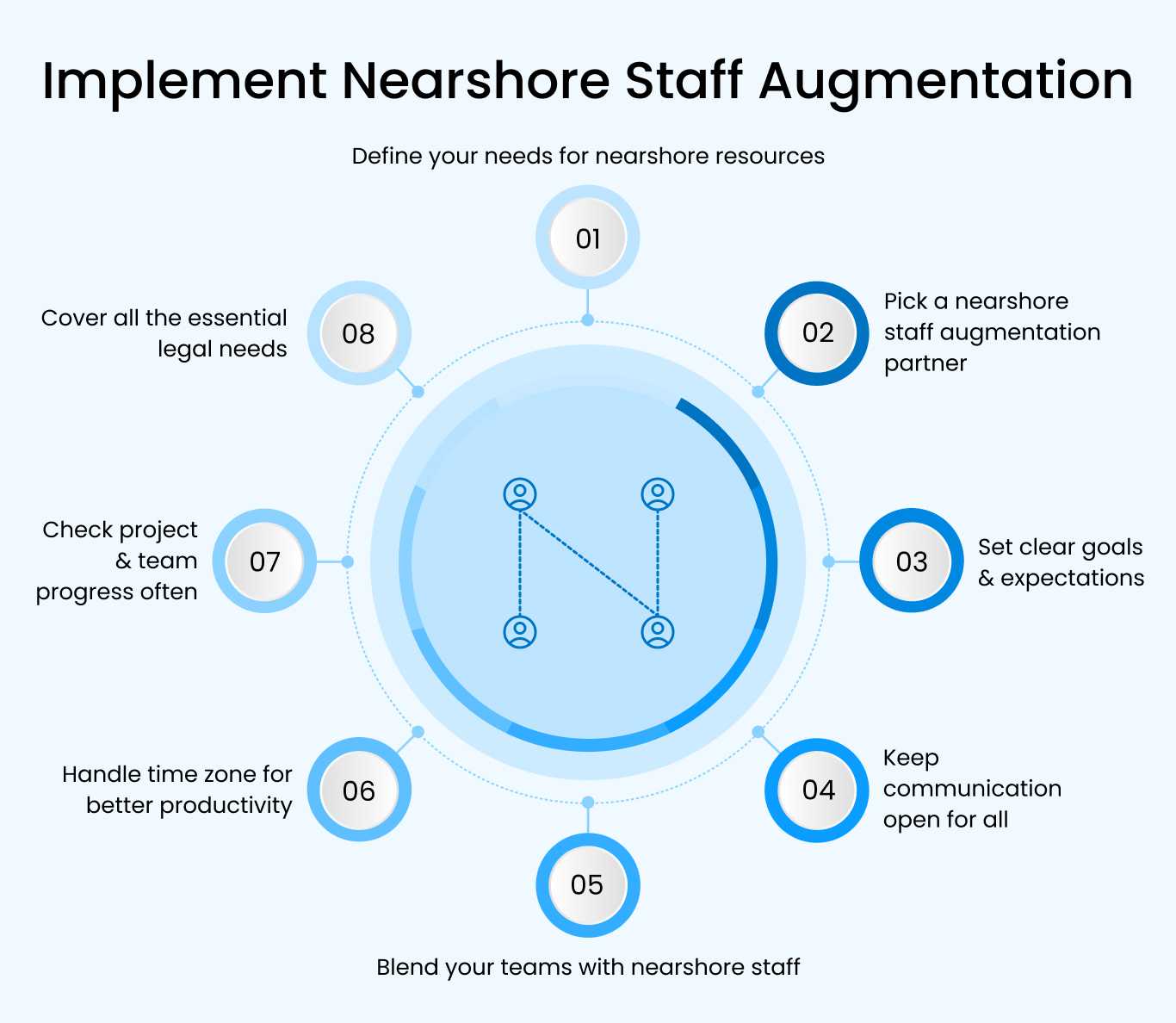
Nearshore teams can help businesses remain competitive by providing skilled professionals who seamlessly integrate with your existing team. Follow these steps to maximize its benefits.
Define your needs for nearshore resources
Have you ever felt like you’re hiring blindly? Start by identifying exactly what your project needs.
- Specify Roles: Decide which positions you need—whether it’s front-end developers to craft user interfaces, UX designers to enhance usability, or customer support agents to manage inquiries.
- List Key Skills: Pinpoint-specific skills such as JavaScript and React expertise for developers, proficiency in Figma or Adobe XD for designers, or multilingual communication for support staff.
- Set Experience Levels: Determine if you need junior staff for simpler tasks, mid-level professionals for complex projects, or senior experts to lead and strategize.
- Define Project Scope: Outline whether it’s a short-term gig (e.g., a website redesign due in 2 months) or a long-term effort (e.g., ongoing app development), complete with timelines and deliverables.
Pick a nearshore staff augmentation partner
Your project’s success hinges on one key decision—choosing the right nearshore staff augmentation partner. Here’s how to get it right.
- Check Their Track Record: Look for business partners with experience in your industry, such as software companies that specialize in fintech or healthcare.
- Read Reviews and Testimonials: Investigate feedback from previous clients to assess reliability, quality of work, and communication.
- Evaluate Their Hiring Process: Confirm they vet skilled professionals thoroughly with technical tests and interviews.
- Assess Communication Skills: Ensure they offer fluent English-speaking staff and use tools like Slack or Zoom for real-time collaboration.
Set clear goals & expectations with your nearshore partner
Goals are the roadmap to success. Without them, your project will just wander—learn how to set the course.
- Define Specific Outcomes: Aim for measurable results, like launching a mobile app with 95% crash-free performance in 6 months.
- Break Goals into Milestones: Create smaller targets, such as finishing the app’s login feature in 3 weeks.
- Assign Responsibilities: Specify who does what, like the nearshore staffing team handling backend development.
- Share a Timeline: Use a shared calendar or Gantt chart to map out deadlines and dependencies.
Keep communication open for all
Communication breakdowns can present challenges even for well-structured projects. Discover how to keep your team in sync.
- Schedule Daily Stand-Ups: Hold short meetings to review progress, address blockers, and plan the next steps.
- Use Project Management Tools: Leverage platforms like Asana or Trello to organize tasks and keep everyone aligned.
- Set up a Communication Protocol: Define when to use email, chat, or video calls for different purposes.
- Assign a Point of Contact: Designate a manager or liaison to handle questions and feedback efficiently.
Blend your teams with nearshore staff
A team divided struggles to succeed. Learn how to unite your in-house and nearshore staff augmentation model for seamless collaboration.
- Include Them in Team Events: Invite nearshore workers to virtual coffee breaks or team-building sessions.
- Share Company Updates: Keep them in the loop on business goals, news, and changes.
- Use Collaborative Tools: Employ platforms like Miro or Figma for real-time brainstorming and design work.
- Encourage Cross-Team Chats: Promote direct communication between your existing team and nearshore staff to build rapport.
Handle time zones for better work productivity
Time zones can be friends or foes—here’s how to make them work for you, not against you.
- Identify Overlapping Hours: For instance, if you’re in New York and your team is in Costa Rica, there will be a 2-hour overlap.
- Set Core Meeting Times: Plan key discussions during overlapping hours, like 10 AM to 12 PM EST.
- Use Async Communication: Rely on email or recorded videos for non-urgent updates to bridge time gaps.
- Be Mindful of Holidays: Respect local holidays in your partner’s country to avoid scheduling conflicts.
Check project & team progress often
Projects can drift off course without you noticing. Stay vigilant with these progress-checking strategies.
- Set Up Weekly Reviews: Discuss completed tasks, upcoming work, and any obstacles.
- Use KPIs to Measure Success: Track metrics like code quality, task completion rates, or customer satisfaction.
- Address Issues Immediately: If delays occur, identify the cause and adjust resources or plans quickly.
- Encourage Feedback: Ask your team for suggestions on improving processes to remain competitive in the market.
Cover all the essential legal needs
Legal oversights can be costly. Protect your business with these essential steps.
- Draft a Detailed Contract: Include scope, timelines, payment terms, and confidentiality clauses.
- Protect Intellectual Property: Have your partner sign an NDA and clarify IP ownership.
- Understand Local Labor Laws: Research employment regulations in the nearshore country to avoid legal issues.
By leveraging nearshore staffing services, you can access highly skilled professionals while optimizing costs and efficiency. With the right augmentation model, your business can thrive in markets without compromising quality or timelines.
Onboard Developers Faster with Nearshore Staffing Services
Need to scale fast? Break through hiring delays. Get nearshore experts onboard and producing results from day one. Act fast to build faster.
5 Challenges & Risks of Nearshore Staff Augmentation
While nearshore staff augmentation offers flexibility, cost savings, and access to skilled professionals, it also presents challenges that businesses must proactively manage. Below is a breakdown of the key risks and strategies to mitigate them.
Challenge 1: Language barriers & communication gaps
Description: Even with nearshore staff augmentation, language differences can lead to misunderstandings, affecting efficiency and collaboration.
- Choose a provider that ensures fluency in your preferred language.
- Leverage real-time collaboration tools like Slack, Microsoft Teams, or Zoom to bridge communication gaps.
- Set clear communication guidelines for emails, meetings, and documentation.
Solution
Challenge 2: Time zone misalignment
Description: Although nearshore staffing reduces extreme time differences seen in offshore outsourcing, a few-hour gap can still cause delays in real-time collaboration.
- Establish overlapping working hours for essential meetings and decision-making.
- Use asynchronous communication methods like recorded video updates and shared documents for non-urgent matters.
- Implement a shared calendar to track availability and work schedules.
Solution
Challenge 3: Cultural differences
Description: Variations in business etiquette, work ethics, and communication styles can lead to misalignment in expectations.
- Provide cultural awareness training for both in-house and nearshore teams.
- Promote inclusivity by recognizing local holidays and customs.
- Encourage open discussions about work styles and expectations to build a cohesive work culture.
Solution
Challenge 4: Integration with the existing team
Description: Remote teams may feel disconnected from the core business, leading to reduced engagement and productivity.
- Include nearshore staff in team meetings, brainstorming sessions, and social events.
- Use collaboration tools like Miro or Figma to enhance teamwork.
- Appoint an internal liaison or manager to ensure smooth coordination.
Solution
Challenge 5: Legal & compliance risks
Description: Hiring nearshore professionals means dealing with different labor laws, tax regulations, and data protection policies.
- Work with legal experts to draft contracts covering confidentiality, payment terms, and compliance.
- Ensure compliance with GDPR or other relevant data security laws.
- Use secure platforms and VPNs to protect sensitive business data.
Solution
How to Choose the Right Nearshore Staffing Partner
When your business demands custom solutions and niche technical skills, selecting the right partner for staff augmentation becomes the top choice. Here’s how to play smart while choosing a nearshore staffing company.
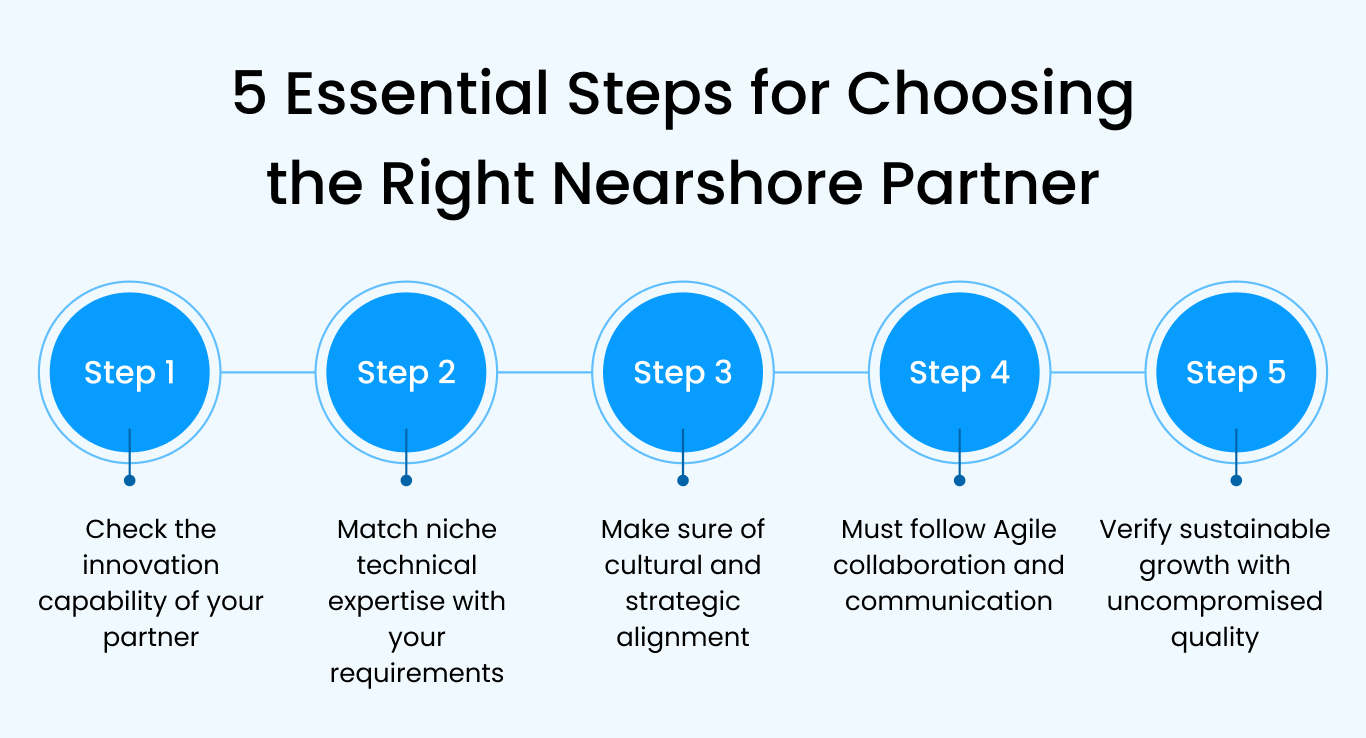
Check the innovation capability of your partner
Seek out partners with a proven history of driving breakthrough ideas and creative problem-solving. Request case studies or success stories that showcase how their innovative approaches have led to measurable improvements. Their commitment to research and staying ahead of industry trends is a critical asset.
Match niche technical expertise with your requirements
Ensure the partner has specialized knowledge of the technologies that matter most to your business. Whether it’s trending tech stacks like AI, advanced analytics, or industry-specific software, verify their technical certifications, team composition, and track record of delivering sophisticated solutions.
Make sure of cultural and strategic alignment
Beyond technical skills, choose a partner who genuinely understands your vision and aligns with your business values. This synergy will facilitate smooth integration with your internal teams and foster an environment where innovative ideas can flourish.
Must follow Agile collaboration and communication
Your staffing partner must embrace Agile methodologies and utilize robust communication practices. This ensures rapid prototyping, iterative development, and the flexibility to pivot as new opportunities arise or market demands shift.
Verify sustainable growth with uncompromised quality
Look for a partner that can scale their services to support your growth without sacrificing innovation or quality. Their ability to manage resources flexibly and maintain high standards over time is essential for sustained success.
By focusing on these factors, you not only secure a nearshore staffing partner who meets your current technical needs but also one who acts as a catalyst for innovation and strategic growth. Ready to transform your digital future? The right partner is just a decision away.
Why are Businesses Choosing Latin America for Nearshore Staffing Needs?
U.S.-based business owners are increasingly tapping Latin America for nearshore staffing needs fullfillment. By partnering with teams in countries like Mexico, Colombia, Argentina, Brazil, Chile, and Costa Rica, they gain all the benefits of real‑time collaboration, cultural alignment, and legal clarity—while keeping costs in check and scaling swiftly to meet growing demand. Here are the common reasons why businesses choose LATAM for nearshore staff augmentation.
- Time‑Zone Alignment: Shared or overlapping hours with the U.S. enable real‑time meetings and faster decision‑making.
- Cultural & Language Fit: Strong English proficiency and cultural affinities reduce misunderstandings and speed up onboarding.
- Familiar Legal Frameworks: Many Latin American countries mirror U.S. IP and contract laws, simplifying compliance and protecting assets.
- Deep Talent Pool: Tech hubs in Bogotá, São Paulo, Buenos Aires, and Mexico City produce skilled engineers, designers, and data scientists.
- Competitive Rates: Lower labor costs than onshore hiring free up the budget for innovation without sacrificing quality.
- Rapid Scalability: Proven recruitment channels and established vendor networks let providers ramp up teams quickly.
- Stable Environments: Key markets offer political and economic stability, ensuring reliable, long‑term partnerships.
Is Nearshore Staff Augmentation Right for Your Business?
Nearshore staff augmentation can offer the benefits of reduced operational costs, seamless communication, and close cultural alignment, making it an attractive option for businesses looking to scale quickly without sacrificing quality. It’s crucial to consider your project’s complexity, the speed you need to ramp up resources, and the level of ongoing support required.
If your business values Agile integration and efficient scaling while maintaining a strategic, long-term partnership, nearshore staff augmentation could be the key to unlocking your next growth phase.
Expand Your Software Team Without Delays – Hire Now
Need to scale fast? Access top-tier nearshore talent ready to integrate seamlessly with your team and keep projects moving without disruption.
FAQs about Nearshore Staff Augmentation
How long does it take to onboard nearshore talent?
Onboarding nearshore talent typically takes 1 to 4 weeks, depending on factors such as the complexity of the role, the availability of qualified candidates, and the integration process within your company. Well-established nearshore staffing partners often have pre-vetted professionals who can be onboarded within days.
Which businesses can benefit the most from nearshore staff augmentation?
Businesses that require fast scalability, cost-efficient staffing, and real-time collaboration benefit the most from nearshore staff augmentation. These include:
- Tech companies & startups: need rapid development cycles
- E-commerce & SaaS firms: expanding digital operations
- Financial & healthcare organizations: requiring regulatory-compliant solutions
- Enterprises: with long-term digital transformation goals
What types of roles can be hired through nearshore staff augmentation?
Nearshore staff augmentation covers a broad spectrum of technical and non-technical roles, including Software developers (Frontend, Backend, Full-Stack, Mobile), DevOps and cloud engineers, QA testers and automation engineers, UI/UX designers, Project managers and business analysts, Data scientists and AI/ML specialists, Cybersecurity experts, and so on.
What are the cost considerations when hiring nearshore talent?
When hiring nearshore talent, cost considerations include:
- Hourly or fixed pricing models: Some nearshore partners charge hourly, while others offer fixed monthly rates.
- Experience level: Senior professionals command higher rates than junior developers.
- Location: Rates vary by country; Latin America and Eastern Europe offer competitive pricing.
- Infrastructure & management costs: Some providers include project management, training, and workspace costs.
- Hidden fees: Be mindful of extra costs for overtime, recruitment, or technology licenses.
Can nearshore teams work in Agile and DevOps environments?
Yes, nearshore teams are well-suited for Agile and DevOps environments. Many nearshore professionals are trained in Scrum, Kanban, and CI/CD practices, enabling them to integrate seamlessly into Agile workflows. Additionally, nearshore teams operate in overlapping time zones, ensuring real-time collaboration, daily stand-ups, and iterative development cycles without delays.
What tools help in managing nearshore teams effectively?
To manage nearshore teams effectively, businesses leverage collaboration and project management tools such as:
- Communication & Collaboration: Slack, Microsoft Teams, Zoom
- Project Management: Jira, Trello, Asana, Monday.com
- Code & Version Control: GitHub, GitLab, Bitbucket
- DevOps & CI/CD: Jenkins, Docker, Kubernetes, Terraform
- Time Tracking & Productivity: Time Doctor, Hubstaff, Toggl
Using the right mix of these tools ensures efficient workflows, transparency, and alignment across distributed teams.



